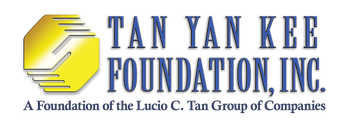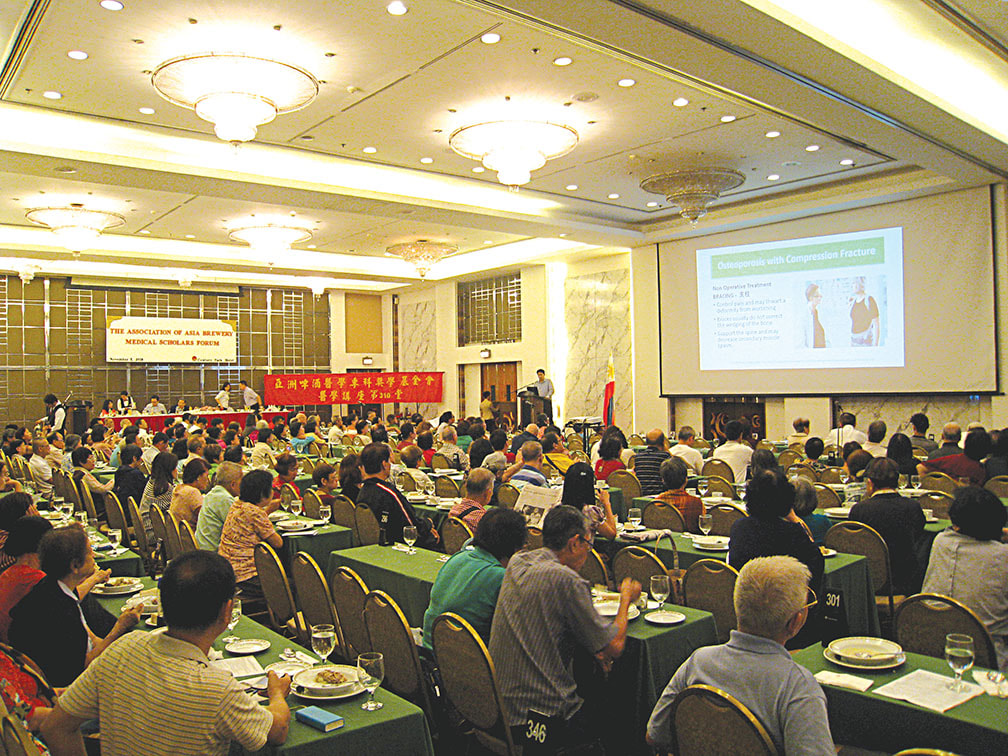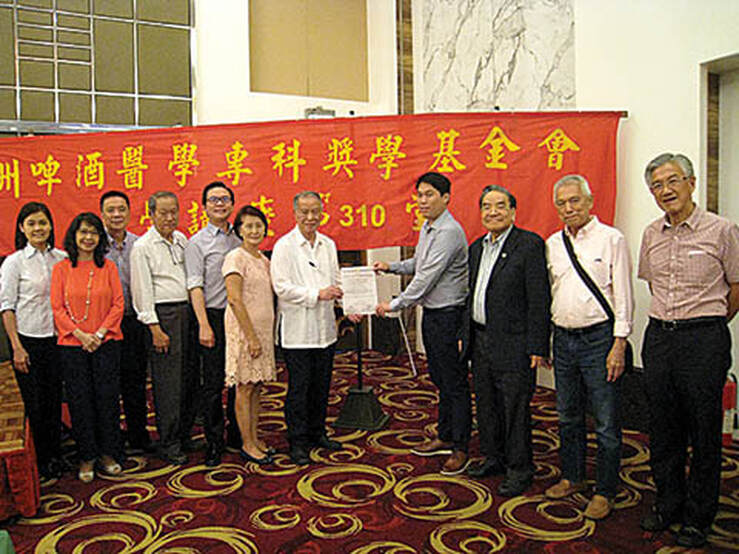Every month, the Tan Yan Kee Foundation, Inc. and the Association of Asia Brewery Medical Specialty Scholars (AABMSS) hold a medical forum designed for laymen. The forum provides people with a venue to learn about the latest medical issues, trends, and available treatment options. Asia Brewery medical scholars render free consultations and discuss pertinent matters in layman’s language. The forum is held at the Grand Ballroom of Century Park Hotel.
Medical Forum No. 306
Common Vascular Diseases
Jeffrey L. Chua, M.D.
(Clinics: Makati Med. – 888-8999, De Los Santos – 893-5762, Cardinal – 727-0001)
Varicose Veins: veins that have become enlarged and twisted
Symptoms:
n Leg heaviness
n Cramping
n Easy tiredness
n Uneasy feeling of the leg
Complication:
Venous stasis ulcers (wounds due to improper functioning of leg venous valves)
Diagnostic: Doppler Ultrasound (check for non-functional valves within the veins affecting the circulation of blood in the lower legs)
Treatment:
n Medical Therapy: help alleviate symptoms
n Surgical: depends on the severity of non-functional valves within the veins
n Sclerotherapy: medicine injection to the vein to irritate the vein to close it
n Microphlebectomy : for larger veins when sclerotherapy will not work
Medical Forum No. 307
Making Work and Workplaces Safe and Healthy
Louie James L. Tan, M.D. (Clinic: Perpetual Succor Hospital – 731-1631)
Occupational Safety and Health: allows one to see oneself as a “worker”; be conscious of worker’s work definitions, tasks, activities, work conditions and environment, work processes, habits, systems, and organization so one can relate how these will affect worker’s health
Work-related and Occupational Illnesses or Injuries: event or exposure in the work environment that either caused or contributed to the resulting condition or aggravated a pre-existing condition. It will result to significant economic burden to various industry sectors in the form of direct and indirect costs, productivity losses, compensation, and disability costs.
Common Illnesses and injuries:
n Occupational eye diseases: cataract
n Occupational lung diseases: asthma, pneumoconiosis, tuberculosis
n Work related musculoskeletal disorders: low back, neck and shoulder pain, shoulder tendinitis, nerve entrapments, carpal tunnel syndrome (repetitive overuse disorders)
n Occupational dermatoses: allergic contact dermatitis, contact urticaria, irritant contact dermatitis
n Cardiovascular diseases: hypertension
n Reproductive health issues
n Heat stress or exhaustion
n Chemical injuries
n Noise induced hearing loss
n Cold induced injuries
Prevention:
n Annual and periodic medical examinations
n Medical surveillance
n Diet counselling
n Exercise programs
n Immunization
n Workplace environment monitoring
n Compliance to health and safety policies and regulations
n Health promotion or education
n Targeted approaches
n Availability of medical services
Hazard Identification / Risk Assessment/ Control (HIRAC) Plan:
n Hazard: refers to something in the workplace that has the potential to cause harm
n Physical (illumination, noise, heat, vibration)
n Chemical (dust, fumes, mist)
n Biologic (bacterial, viral, parasites)
n Ergonomic
n Psychosocial
Risk: likelihood of the hazard causing the harmful effect.
Control: failure to establish appropriate measures will often lead to injury or disease
n Elimination of the hazard source
n Use policies or instructions to limit exposures
n Physical barrier alterations or change in provisions to improve accessibility and safety
n Substitution with similar but safer product
n Wear protective equipment (like gloves, masks, etc.)
Medical Forum No. 308
Common Degenerative Shoulder Problems: A Basic Guide in Diagnosis and Treatment
Jeremy James C. Munji, M.D. (Clinics: UST Hospital – 731-3001, Delos Santos – 893-5762, Health Cube [Promenade] - 650-1111, Providence – 558-6999)
Degenerative Shoulder Problems: not athletic and above 40 years old
Symptoms:
n Non-traumatic pain
n Muscle weakness
n Clicking or “creaking” between bones and cartilage
Causes:
Impingement Syndrome or “Rotator Cuff Tendon Tears”: due to a tilted acromion or a swollen rotator cuff tendon with subacromial bursitis, rubbing of the supraspinatus on the bone of the shoulder blade as one lifts the arm over the head occurs. This promotes pain, clicking and eventual tearing of the Supraspinatus Rotator Cuff Tendon
n Rotator Cuff Tendon: a group of four musculo-tendinous structures inside the shoulder
n Supraspinatus: lifting of the arms
n Subscapularis: reach the back pocket or scratch the back
n Infraspinatus and Teres Minor: open refrigerator doors or rotating the arm externally
Adhesive Capsulitis or “Frozen Shoulder” : a condition where the capsule surrounding the shoulder becomes inflamed and fibrotic. The capsule stiffens and disables patient from doing full motion of the shoulder. Rather than a disease entity by itself – it is a symptom of an internal derangement in the shoulder such as chronic and neglected rotator cuff tears.
Glenohumeral Joint Arthritis: not very common for Filipinos and Asians but may occur due to cartilage degeneration or degradation of the “bony lining” of the shoulder joint leading to pain and stiffness. This problem if felt more in the morning with limitation of range of motion of the shoulder joint and may improve with motion.
Treatment:
n Rehabilitation: multiple exercises involving stretching, scapular stabilizing and rotator cuff strengthening for reducing pain and improving function, benefit only not big, complete and retracted Rotator Cuff tears or anatomic impingement from a tilted acromion
n Lasers and Deep Heat Ultrasound: for small partial tears with biceps synovitis or subacromial bursitis
n Platelet Rich Plasma Injection: relies on multi-potential cells that enhance healing, is an additive in surgery that will benefit small to medium tears
n Corticosteriods: anti-inflammatory which ends pain but is best coupled with rehab regimen
n Arthroscopy Surgery: done minimally invasively, through putting small windows in the shoulder and fixing large and complete tear, non-improvement with 2-3 months or patients who have a higher functional demand or want more than just pain relief but also return of power and strength of rehabilitation through a camera
Medical Forum No. 309
Obesity is a Disease that Needs Treatment
Michelle Bernadette C. Lim-Loo, M.D. (Clinics: CGH –711-4141, Medical City – 988-1000, Cardinal – 727-0001, Providence –558-6999, Infant Jesus – 731-2771, Rizal – 865-8400)
Being obese means having excessive body fat which can lead to diseases to the body including diabetes, heart disease, hypertensions, arthritis, sleep apnea, stroke, infertility, cancer and others.
Most common method for weight loss is by healthy eating and exercise. However, this is very difficult for the obese due hormonal imbalances brought about by the excessive body fat. The body adapts to the weight loss by reducing their metabolism. This results in weight regain when the diet and exercise is stopped.
Bariatric surgery is a weight loss treatment that resets the hormonal imbalance in the body. The surgery results in reduced hunger sensation, increased satiety, changes in taste, smell and eating behavior, and increased body metabolism. Bariatric surgery results in long term sustainable weight with improvement of obesity related diseases like diabetes.
Medical Forum No. 310
How Is Your Back?: Low Back Pain and Other Spine Problems in the Elderly
Austin Samuel L. Lim, M.D. (Clinics: CGH. – 711-4141, Metropolitan – 863-2500)
Common Spine Disorders:
n Low Back Pain: common problem as people ages
Risk Factors:
n Smoking
n Obesity
n Age
n Female
n Physically and psychologically strenuous work
n Sedentary
Causes:
n Fractures
n Infection
n Tumors
n Cauda Equina Syndrome
n Muscle pain and strain
Degenerative Disc Disease: wear and tear or breakdown of the intervertebral discs, normally begins with loss of fluids
Facet Joint Arthropathy: arthritis of the joints that connect the vertebrae to one another, bone spurs can be formed
around the joint due to bone rubbing
Spondylolisthesis: one of the vertebrae of the spine slips forward in relation to another
Lumbar Spinal Stenosis: a condition in which the vertebral canal is narrowed
Herniated Disc: outer covering is weakened or torn and the soft inner tissue extrudes
Treatment: will improve after 4 to 6 weeks
n Non-operative: exercise, anti-inflammatory medications, brace to minimize muscle spasm, one or two days bed rest
n Operative: Discectomy, Spinal Fusion, Posterior Lumbar Laminectomy or Decompression
Osteoporosis and Compression Fractures: decrease in bone mass, can cause fractures with no trauma
Risk Factor: post-menopausal women
Symptom: back pain
Diagnosis:
n X-ray
n MRI or CT scans: evaluate fractures
n Bone Mineral Density: confirms osteoporosis
Treatment: medication addressing osteoporosis
Non-operative:
n Bisphosphonates: maintain and possibly increase bone mass
n Non-steroidal anti-inflammatory drugs
n Calcitonin: slow the breakdown of the minerals in bone
n Calcium and vitamin D
n Brace: control pain and may thwart a deformity from worsening, support the spine and may decrease secondary muscle spasm, but can’t correct bone wedging.
Operative: to control pain, improve the deformity and decompress the nerve roots or spinal cord
n Vertebroplasty: involves an injection of bone cement into vertebrae
n Kyphoplasty: similar to vertebroplasty, except that a balloon is inflated in the vertebra to create a space before the filling with bone cement
Cervical Degenerative Disc Disease: arthritic changes in the aging spine and joints
Symptoms:
n Pain
n Numbness
n weakness of the neck, shoulder, arm or hand;
n leg weakness
n body imbalance
Diagnosis:
- X-ray
- CT scan: detect fractures, congenital anomalies and tumors
- MRI: assess alignment and detect soft tissue problems
Treatment:
- Non-operative: immobilization with a collar, non-steroidal anti-inflammatory medications, physical therapy
- Operative: anterior cervical discectomy and fusion; posterior decompression and stabilization
Care:
- Quit smoking
- Choose body conforming mattress
- Walking, jogging, biking, swimming, balancing, yoga, tai chi and exercise to strengthen abdominal muscles
- Maintain a healthy weight: overweight increased risk of low back pain
- Use safe posture: body’s position can raise your risk of experiencing low back pain
Signs of Developing Serious Spinal Disorders:
- Neurological impairment
- Bladder or bowel dysfunction
- Inability to ambulate
- Pain in patients below 20 and above 55 years old
- Severe morning stiffness
- High fracture risk (e.g. osteoporosis)
- Immunosuppressed status
- History of malignancy
- Fever, malaise, weight loss
- Pain unchanged on rest, posture modification or after 4 weeks of treatment
Medical Forum No. 311
Common ENT Problems
Ryan Uy Chua, M.D. (Clinics: UST Hospital – 731-3001, Medical City – 988-1000, Centuria Medical Makati – 793-8606)



 RSS Feed
RSS Feed